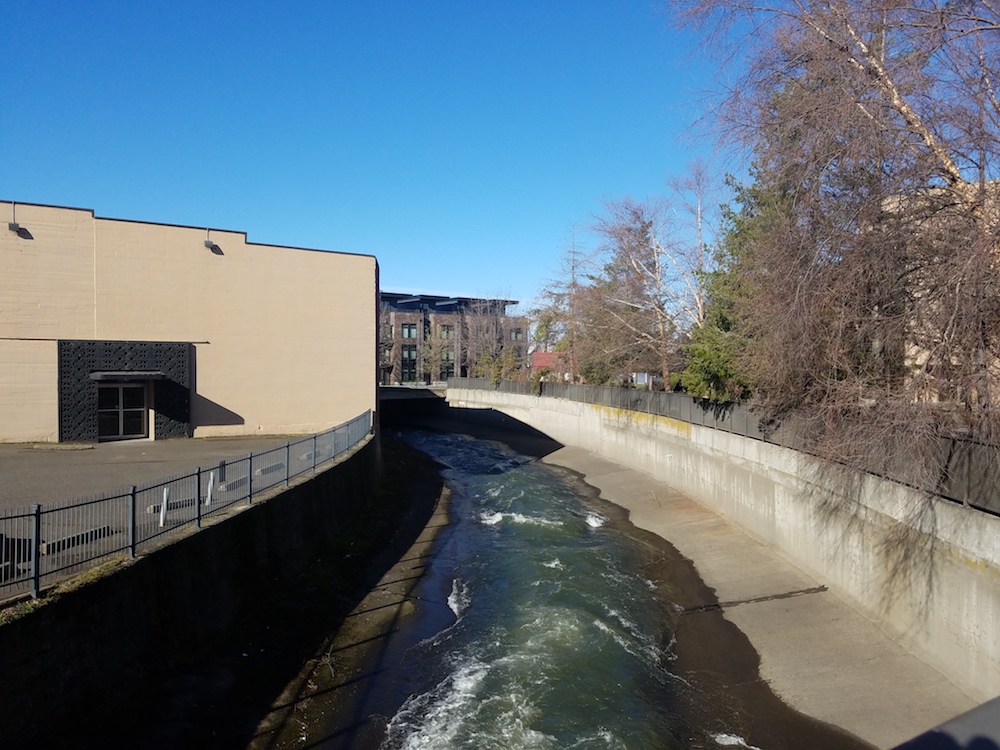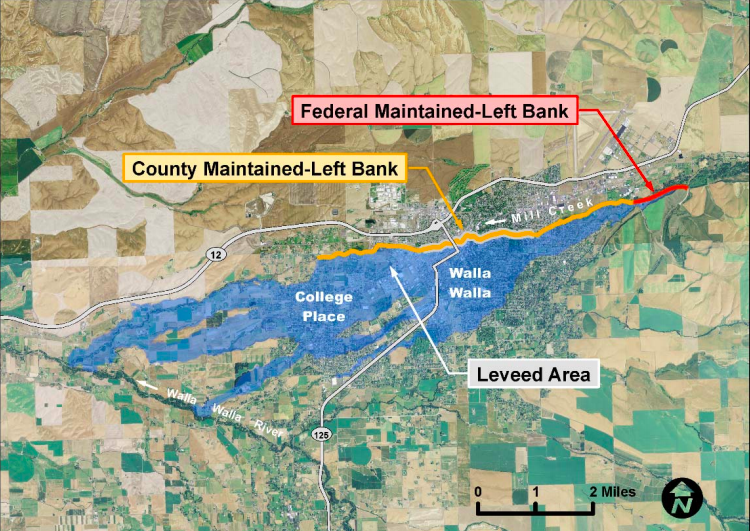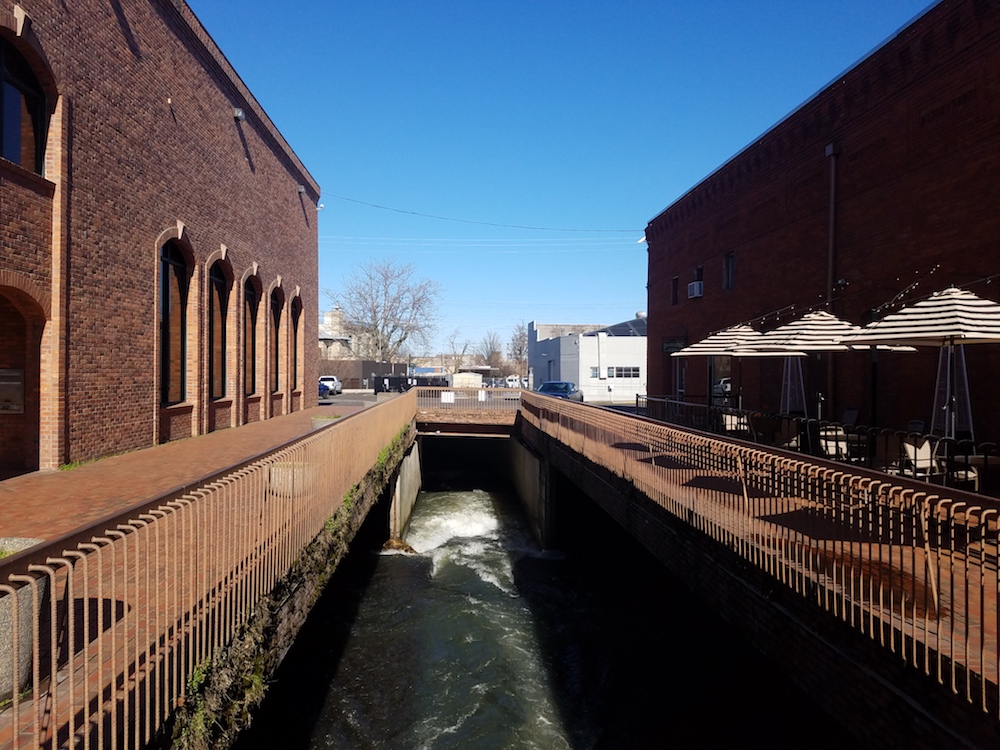When Your Downtown Is Built Over a Flood-Prone Creek

Walking along Main Street in downtown Walla Walla, you might miss Mill Creek. Michael Grass / Route Fifty
You can’t always out-engineer the uncontrollable forces of water. But Walla Walla, Washington has—thus far—been pretty fortunate in its efforts to tame a local stream.
WALLA WALLA, Wash. — At the corner of S. First Avenue and E. Main Street in the heart of this city’s historic downtown, you can hear rushing water but might not be able to immediately identify its source. Follow the sound: Looking north toward the red-brick walkway, there’s a narrow trench full of rushing water down below.
This was the site of Walla Walla’s first bridge over Mill Creek, which supported flour- and saw- milling businesses in this agriculturally rich region in southeast Washington state near the Oregon border. The Walla Walla Valley is today well known for its wine production and wine-related tourism.
While there’s a lot of natural beauty in the local topography, which features the Blue Mountains to the southeast and wide-open vistas westward out over wine country, Mill Creek’s route through Walla Walla is mostly sterile and contained.
Its waters travel through a highly-engineered concrete cut-and-cover tunnel and trench that curves in a flattened-out “S” shape through downtown. Although you can’t see it from street level, Mill Creek flows directly under the Die Brucke Building, home to bookstore, and other few other downtown retailers, which was built to span the creek channel.
In 1931, massive flash flooding, generated by a combination of heavy rain and snowmelt from the nearby Blue Mountains, hit the Walla Walla Valley. Since much of the downtown area sits on fairly level ground adjacent to Mill Creek, flood waters inundated a large portion of the city.
This archival footage of the 1931 floods from the U.S. Army Corps of Engineers shows the extent of the flooding in the city:
When you normally think of places that have highly engineered local waterways and drainage, cities like Houston, Miami and New Orleans often come to mind first.
But many smaller cities like Walla Walla—which has a population of around 32,000 residents—wouldn’t exist as in their current form if they weren’t able to figure out a way to keep floodwaters from inundating them regularly.
Like so many cities that were founded based on their proximity to water, Walla Walla relies on levees for protection from Mill Creek, which usually runs high this time of year when snowmelt from the nearby Blue Mountains is compounded by localized heavy rains, causing flash flooding.
The leveed area in Walla Walla includes 8,600 structures and is home to approximately 19,000 residents, according to a May 2016 Army Corps backgrounder on its Mill Creek Project.
The U.S. Army Corps of Engineers Walla Walla District, which is headquartered here and covers much of the Inland Northwest, has played a major role in trying to tame Mill Creek, building a dam upstream from the city that can divert some of the flow into an adjacent man-made reservoir, Bennington Lake, during times of high water volumes.
Since the Army Corps opened the Mill Creek Dam and the Bennington Lake diversion in 1942—additional levees were constructed in the years that followed—Walla Walla has been spared major flood damage. The local flood-control infrastructure was credited in preventing millions of dollars in damage during severe flooding on Mill Creek in 1996.

But there’s an important thing to remember with the local flood control structures, which are maintained by the Army Corps and the Walla County Public Works’ Mill Creek Flood Control Zone District: The infrastructure “reduces the risk of flooding, but does not eliminate it.” That’s according to the Army Corps backgrounder, which also notes that “continued safe operation will require increasing amounts of maintenance.”

Even though we’d like to think of a highly engineered waterway as having some sort of permanence, the levees that line Mill Creek’s left bank are at risk of “progressive embankment erosion during a severe flood event,” according to the Army Corps’ backgrounder on Mill Creek’s flood protection. “High flows have the potential to undermine and damage weirs, causing excessive erosion at isolated locations along the base of the levee.”
If that were to happen, Walla Walla could see something like the 1931 floods, or worse, under certain conditions.
Funding such maintenance for vital flood control infrastructure has been a long-term challenge for federal, state and local authorities. It’s is a story playing out across the nation, whether it be ensuring that New Orleans’ pump operations can keep up during periods of heavy rains or levees protecting much of the Sacramento area hold up during major flooding.

But flood protection comes with costs beyond construction and maintenance. There can be significant environmental and ecological impacts—in Walla Walla, much of the discussion about Mill Creek, beyond flood control, has focused on improving conditions for fish migration, which can sometimes be highly difficult in an engineered waterway compared to a natural water course.
On a larger scale, decades of flood protection infrastructure along the Mississippi River has deprived the eroding Louisiana coastline of vital sediment that otherwise would have been deposited naturally. If the U.S. Army Corps of Engineers hadn’t built the Old River Control Structure north of Baton Rouge in the 1960s, the continent’s longest river and largest by discharge volume would have likely changed its main watercourse so it traveled to the Gulf of Mexico via the Atchafalaya River and bypass New Orleans. (Like other rivers, the Mississippi has changed course throughout its hydrological history. It’s only been until relatively recently that humans decided to tinker with how major river systems flowed.)
While Mill Creek’s hydrological dynamics are, comparatively, far more simple than those that shape the course of the Mississippi River and Louisiana’s disappearing coastline, they have influenced the Walla Walla Valley in fundamental ways.
In a recent article in the Walla Walla Union-Bulletin, Alex Coak, a recreational activities coordinator with Tri-State Steelheaders, reminded local readers of the about the importance of sediment to the agriculturally rich valley:
If the waterway overtops its banks, the water will spread across the floodplain, slowing down as it does so. This allows the sediments in the water to settle out of suspension and be deposited on the ground, which can greatly increase the quality and fertility of the soil.
This is one reason so many vineyards and farms can be found in current or former floodplains, as the soils have been enriched over the years by repeated high-water events. It’s also the reason humans and rivers come into conflict so often, as many homes, farms and other structures are located within floodplains. These flood-deposited nutrients enhance plant growth adjacent to the stream, allowing trees and other plants to grow and provide beneficial shade, as well as food for the stream and its inhabitants.
So while Walla Walla’s levees and flood control structures keep wineries and Main Street tasting rooms dry, they also cut off local agricultural lands from normal flood sedimentation, which are whisked downstream. In Walla Walla and so many other places, the tools of water management are often double-edged swords.
Michael Grass is Executive Editor of Government Executive’s Route FIfty and is based in Seattle.
NEXT STORY: Trump to Stump for Infrastructure—Again






